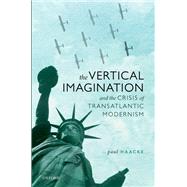The Vertical Imagination and the Crisis of Transatlantic Modernism
, by Haacke, Paul- ISBN: 9780198851448 | 0198851448
- Cover: Hardcover
- Copyright: 5/11/2021
From the invention of skyscrapers and airplanes to the development of the nuclear bomb, ideas about the modern increasingly revolved around vertiginous images of elevation and decline and new technologies of mobility and terror from above. In The Vertical Imagination and the Crisis of Transatlantic Modernism, Paul Haacke examines this turn by focusing on discourses of aspiration, catastrophe, and power in major works of European and American literature as well as film, architecture, and intellectual and cultural history.
This wide-ranging and pointed study begins with canonical fiction by Franz Kafka, Virginia Woolf, James Joyce, and John Dos Passos, as well as poetry by Guillaume Apollinaire, Hart Crane, and Aimé Césaire, before moving to critical reflections on the rise of New York City by architects and writers from Le Corbusier to Simone de Beauvoir, the films of Alfred Hitchcock and theories of cinematic space and time, and postwar novels by Kurt Vonnegut, Thomas Pynchon, and Leslie Marmon Silko, among many other examples. In tracing the rise and fall of modernist discourse over the course of the long twentieth century, this book shows how visions of vertical ascension turned from established ideas about nature, the body, and religion to growing anxieties about aesthetic distinction, technological advancement, and American capitalism and empire. It argues that spectacles of height and flight became symbols and icons of ambition as well as direct indexes of power, and thus that the vertical transformation of modernity was both material and imagined, taking place at the same time through the rapidly expanding built environment and shifting ideological constructions of "high" and "low."
This wide-ranging and pointed study begins with canonical fiction by Franz Kafka, Virginia Woolf, James Joyce, and John Dos Passos, as well as poetry by Guillaume Apollinaire, Hart Crane, and Aimé Césaire, before moving to critical reflections on the rise of New York City by architects and writers from Le Corbusier to Simone de Beauvoir, the films of Alfred Hitchcock and theories of cinematic space and time, and postwar novels by Kurt Vonnegut, Thomas Pynchon, and Leslie Marmon Silko, among many other examples. In tracing the rise and fall of modernist discourse over the course of the long twentieth century, this book shows how visions of vertical ascension turned from established ideas about nature, the body, and religion to growing anxieties about aesthetic distinction, technological advancement, and American capitalism and empire. It argues that spectacles of height and flight became symbols and icons of ambition as well as direct indexes of power, and thus that the vertical transformation of modernity was both material and imagined, taking place at the same time through the rapidly expanding built environment and shifting ideological constructions of "high" and "low."







